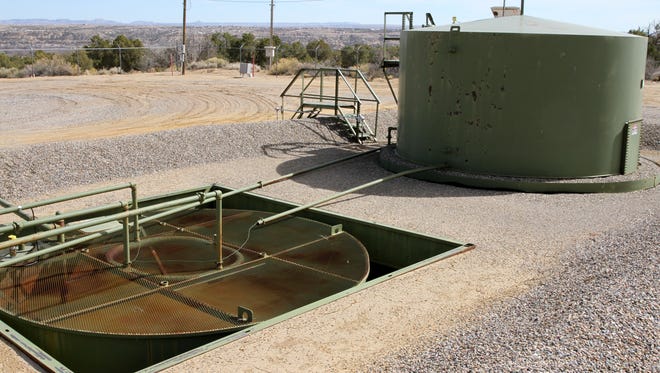Environmental advocate warns legislators of loopholes in draft methane rules

FARMINGTON — As the comment period for methane rules nears its Sept.16 closing date, an environmental advocate urged New Mexico lawmakers to close what he describes as loopholes in the draft rules that could allow for continued emissions from oil and gas infrastructure.
But a representative of New Mexico Environment Department said his assertions that the majority of wells would go unchecked are false.
Methane was one of the discussion topics at the state's Water and Natural Resources Committee meeting this week, which was broadcast live on nmlegis.gov. Other topics included bonding requirements and orphaned wells.
Methane is a potent greenhouse gas that contributes to climate change and can be released through leaks and flaring while extracting oil and natural gas. The impacts of methane emissions to human health and the environment prompted the state to begin drafting methane rules following an executive order Gov. Michelle Lujan Grisham signed shortly after taking office.
Environmental Defense Fund Director of Regulatory and Legislative Affairs Jon Goldstein said loopholes in the draft rules would mean 95% of the wells in the state would go unchecked.
Read More:Methane regulations among the agenda topics for legislative committee
Goldstein said there are two loopholes that Environmental Defense Fund would like to see closed. These are exemptions for low-producing wells sometimes called stripper wells as well as an exemption for low-emitting wells that produce less than 1,500 tons of methane emissions annually.
In the San Juan Basin, where many of the wells are stripper wells, Goldstein said 94% of the wells would be exempt. Meanwhile, in the Permian Basin, 87% of the wells would be exempt.

But state officials said Goldstein’s statement is false. New Mexico Environment Department’s Environment Protection Division Director Sandra Ely explained that there are two draft rules, one from NMED and the other from the Energy, Minerals and Natural Resources Department. The two rules are intended to work together and some of the exemptions in the NMED rules are filled by the EMNRD rules.
NMED's rule focuses on ozone and EMNRD's rule focuses on greenhouse gas emissions. Officials say rules relating to ozone precursors will also reduce the methane emissions.
Tiffany Polack, deputy director of EMNRD's Oil Conservation Division, added that the rules were purposefully drafted to allow flexible technology solutions. This will allow for the industry to create solutions and for new technology to be implemented as it comes onto the market.
Patrick Padilla, EOG Resources director of regulatory and government relations, gave examples of some of the experiments his company has done to increase the amount of gas captured rather than vented or flared. One way the EOG did this was by injecting gas into a low producing well to store rather than flare when markets go offline. Padilla said EOG Resources is the largest producer of crude oil in the state.

Increasing the amount of gas captured also helps state finances.
Danny Martinez, the director for the State Land Office's Royalty Management Division, said the state can receive royalties for vented and flared gas, however it currently receives royalties on less than 1% of the gas that is vented or flared. If the gas is sold, more funding gets to the state via royalties.
Energy:2 groups are arguing that portions of the Energy Transition Act are unconstitutional
New bonding rule will come on the books in 2021
In addition to talking about methane, legislators heard discussion about bonding rules and orphaned wells.
More than 200 oil and gas related companies have filed for bankruptcy in 2020 and New Mexico has not been immune from these economic challenges, according to Tarin Nix, the deputy commissioner of public affairs for the State Land Office.
This is one reason that a study is currently underway to look at bonding requirements for wells and infrastructure on state land.
Bonding ensures wells will be plugged and sealed. Nix said there is not a single company in New Mexico that is fully bonded to cover the costs of plugging and abandoning its infrastructure. Without adequate bonding, taxpayers will be left footing the bill if a company is unable to pay for the well to be plugged and sealed.
New Mexico's reclamation fund is providing millions of dollars for plugging orphaned wells each year. Orphaned wells have no owner or operator of record, often because of bankruptcy, or have not been properly plugged or abandoned.
More:San Juan Generating Station renewable energy plan gets approval from PRC
Oil:Concerns about moving forward with land use plan impacting Greater Chaco expressed
Gabe Wade, Oil Conservation Division deputy director, said there are 687 orphan wells in New Mexico and the average cost of plugging a well is $35,000. He said the state has about $24 million of liability for orphan wells.
The state has allocated $5 million from the reclamation fund to plug orphan wells during this fiscal year and, since 2015, the state has spent $4.5 million plugging 136 wells on state trust land.
When it comes to federal land, Wade said the Oil Conservation Division receives grant money from the Bureau of Land Management to plug wells. Between 2015 and 2020, about $1.7 million was spent on plugging 49 wells on federal land and the OCD just received a $5 million grant to plug wells over the next five years, Wade said.
Hannah Grover covers government for The Daily Times. She can be reached at 505-564-4652 or via email at hgrover@daily-times.com.
Support local journalism with a digital subscription: http://bit.ly/2I6TU0e